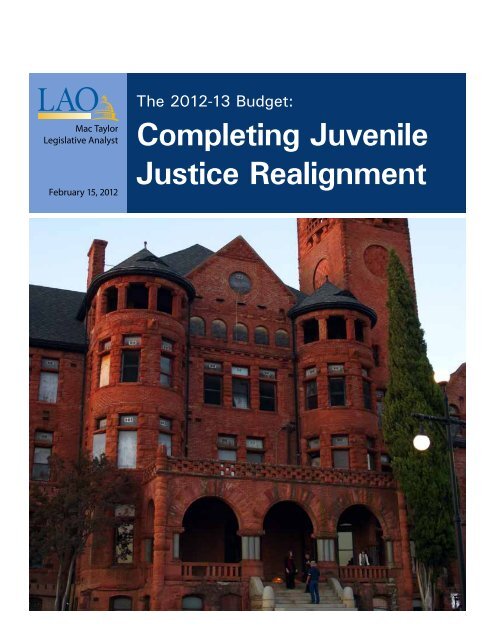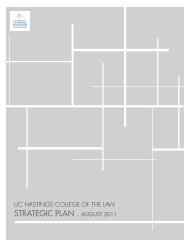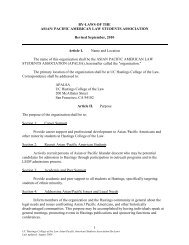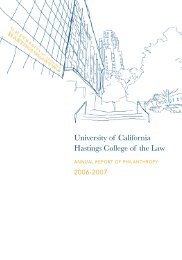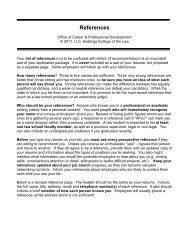Completing Juvenile Justice Realignment - California Legislative ...
Completing Juvenile Justice Realignment - California Legislative ...
Completing Juvenile Justice Realignment - California Legislative ...
You also want an ePaper? Increase the reach of your titles
YUMPU automatically turns print PDFs into web optimized ePapers that Google loves.
The 2012-13 Budget:<br />
mac Taylor<br />
<strong>Legislative</strong> Analyst<br />
<strong>Completing</strong> <strong>Juvenile</strong><br />
February 15, 2012<br />
<strong>Justice</strong> <strong>Realignment</strong>
2012-13 Budge t<br />
Cover photograph: Preston Castle, opened in 1894 as the Preston School of Industry in Ione, <strong>California</strong>. <strong>Juvenile</strong> wards of<br />
the state were housed in Preston Castle until 1960 when a new facility was built adjacent to the castle. This facility was<br />
closed in 2011 as a result of the decreasing population in the state’s juvenile facilities.<br />
This file is licensed under the Creative Commons Attribution-Share Alike 3.0 Unported license (http://commons.wikimedia.<br />
org/wiki/File:Preston_Castle_1.jpg).<br />
2 <strong>Legislative</strong> Analyst’s Office www.lao.ca.gov
2012-13 Budge t<br />
Executive Summary<br />
Over the past 16 years, the Legislature has enacted various measures which realigned to counties<br />
a significant share of responsibility for managing juvenile offenders. Under current law, only<br />
juveniles adjudicated for a serious, violent, or sex offense can be sent to state facilities by the juvenile<br />
courts. As a result, 99 percent of juvenile offenders are housed or supervised by counties.<br />
As part of his 2012-13 budget plan, the Governor proposes completing the realignment of<br />
juvenile justice by stopping new admissions of offenders to state Division of <strong>Juvenile</strong> <strong>Justice</strong> (DJJ)<br />
facilities on January 1, 2013. The Governor would provide counties with an unspecified level of<br />
funding to manage wards who would otherwise have been committed to DJJ after that date, as well<br />
as $10 million in planning grants in the current year.<br />
We recommend that the Legislature adopt a comprehensive juvenile justice realignment plan<br />
that completes the shift of responsibility to counties. We believe the Governor’s proposal has merit<br />
on both policy and fiscal grounds, but that the Legislature could address various concerns with the<br />
administration’s plan. Specifically, we recommend developing a funding approach that promotes<br />
innovation and efficiency, establishing a transition plan for DJJ, providing state oversight and<br />
technical assistance through the newly created Board of State and Community Corrections (BSCC),<br />
taking measures to reduce the number of juveniles tried in adult court, and requiring counties to<br />
house minors tried in adult court until age 18.<br />
www.lao.ca.gov <strong>Legislative</strong> Analyst’s Office 3
4 <strong>Legislative</strong> Analyst’s Office www.lao.ca.gov<br />
2012-13 Budge t
2012-13 Budge t<br />
<strong>Juvenile</strong> <strong>Justice</strong> System in <strong>California</strong><br />
Overview of System<br />
When a juvenile is arrested by a local law<br />
enforcement agency in <strong>California</strong>, there are<br />
various criminal justice outcomes that can occur<br />
depending on the circumstances of the offense and<br />
the criminal history of the offender. Many juveniles<br />
who are arrested, particularly if their alleged<br />
offenses are more serious, are referred to county<br />
probation departments. (Probation departments<br />
also receive referrals from non-law enforcement<br />
entities and people—such as schools and parents.)<br />
The probation department then has the option<br />
to close the case, place the juvenile in a diversion<br />
program or on informal probation, or refer the case<br />
to the courts. Most such referrals are adjudicated<br />
in juvenile court, but depending on the nature of<br />
the alleged offense and the age of the accused, some<br />
cases may be prosecuted in adult criminal court.<br />
The courts place almost all juvenile offenders under<br />
the supervision of county probation departments.<br />
A smaller number of juvenile offenders, however,<br />
are sent to state institutions, either a juvenile facility<br />
operated by DJJ within the <strong>California</strong> Department<br />
of Corrections and Rehabilitation (CDCR) or state<br />
prison.<br />
Because state and federal law require juvenile<br />
offenders to be separated from adult prison<br />
inmates, juveniles sentenced to state prison in adult<br />
court are currently housed in a DJJ facility. In some<br />
cases, these wards are transferred to prison after<br />
they reach age 18. In cases where wards are able<br />
to complete their sentence by age 21, they may be<br />
allowed to complete their sentence in DJJ rather<br />
than being transferred to state prison.<br />
According to the <strong>California</strong> Department of<br />
<strong>Justice</strong>, there were about 186,000 juvenile arrests<br />
made in <strong>California</strong> in 2010, including 52,000<br />
juvenile felony arrests. In the same year, the courts<br />
ordered counties to manage about 60,000 juvenile<br />
offenders, generally on county probation or in a<br />
local facility, and sent 740 juvenile offenders to DJJ<br />
or state prison. Figure 1 (see next page) displays<br />
the outcomes of the juvenile justice system in<br />
<strong>California</strong>.<br />
Most Responsibility for <strong>Juvenile</strong> Offenders Has<br />
Shifted to Counties Under Prior <strong>Realignment</strong>s<br />
Over the years, the Legislature has taken steps<br />
to shift key responsibilities for managing juvenile<br />
offenders to the counties. The three prior juvenile<br />
justice realignments are discussed below.<br />
• Sliding Scale. In 1996, the Legislature<br />
passed Chapter 6, Statutes of 1996 (SB 681,<br />
Hurtt), which established a sliding scale fee<br />
to counties committing wards to the state.<br />
Under this arrangement, counties were<br />
required to pay a share of the state’s costs<br />
to house each ward sent to DJJ (then called<br />
the Department of the Youth Authority),<br />
with a higher share of costs paid for<br />
lower-level offenders than for higher-level<br />
offenders. Senate Bill 681 was designed to<br />
incentivize counties to manage less serious<br />
offenders locally and decrease state costs.<br />
• Lower-Level Offenders. Approximately a<br />
decade later, the state enacted Chapter 175,<br />
Statutes of 2007 (SB 81, Committee on<br />
Budget and Fiscal Review), which limited<br />
admission to DJJ only to juveniles who<br />
are violent, serious, or sex offenders. To<br />
help them manage these new responsibilities,<br />
SB 81 also established the<br />
Youthful Offender Block Grant (YOBG),<br />
which provided counties with $117,000<br />
for each ward estimated to have been<br />
realigned under the measure. In 2011-12,<br />
$93.4 million in YOBG funding was<br />
provided to counties. Chapter 175 also<br />
www.lao.ca.gov <strong>Legislative</strong> Analyst’s Office 5
2012-13 Budge t<br />
Figure 1<br />
Outcomes of <strong>Juvenile</strong> <strong>Justice</strong> System in <strong>California</strong><br />
2010<br />
25,897<br />
Non-Law Enforcement<br />
Referrals to Probation<br />
185,867<br />
Total Arrests<br />
186,019 a<br />
Total Referrals to Probation<br />
38,815 a<br />
Turned Over to Other<br />
Authorities or Released<br />
51%<br />
Cases Heard in <strong>Juvenile</strong> Court<br />
49%<br />
40% Cases Dismissed or Transferred<br />
9% <strong>Juvenile</strong>s Placed in Diversion Programs or on Informal Probation<br />
0.4% Cased Filed in Adult Court<br />
29% <strong>Juvenile</strong>s Made Ward of Court 21%<br />
17% <strong>Juvenile</strong>s Placed on Home Supervision<br />
10% <strong>Juvenile</strong>s Placed in County Facility<br />
3% <strong>Juvenile</strong>s Placed With Other Public or Private Agency<br />
0.2% <strong>Juvenile</strong>s Sent to the Division of <strong>Juvenile</strong> <strong>Justice</strong><br />
12% Cases Dismissed<br />
5% <strong>Juvenile</strong>s Placed on Informal or Non-Ward Probation<br />
4% Diversion, Deferred Entry of Judgement, or Transferred<br />
0.1% Cases Sent to Adult Court<br />
a Numbers do not sum due to difference in reporting sources.<br />
Detail may not total due to rounding.<br />
provided counties with $100 million in<br />
lease-revenue funding to construct or<br />
renovate juvenile facilities, an amount that<br />
was later increased to $300 million.<br />
• Parolees. More recently, as part of the<br />
2010-11 budget, the Legislature realigned<br />
from the state to county probation departments<br />
full responsibility for supervising<br />
in the community all wards released from<br />
DJJ. As part of that measure, the Legislature<br />
also established the <strong>Juvenile</strong> Reentry Grant,<br />
which provides counties with ongoing<br />
funding for managing these parolees. In<br />
2011-12, $3.7 million in <strong>Juvenile</strong> Reentry<br />
Grant funds were paid to counties.<br />
substantially since 1996. As shown in Figure 2, the<br />
DJJ ward population has decreased from about<br />
9,700 wards in 1996 to 1,100 today. The figure<br />
also shows that the number of juveniles housed in<br />
county facilities has declined somewhat over the<br />
same time period. Counties now house a much<br />
higher share of the total number of juveniles in<br />
Figure 2<br />
Number of Offenders in Youth<br />
Correctional Facilities Has Declined<br />
Average Daily Population<br />
14,000<br />
12,000<br />
10,000<br />
8,000<br />
DJJ Only Supervises More Serious Offenders<br />
Declining DJJ Population. As a result of these<br />
prior realignments, as well as an overall reduction<br />
in juvenile crime, the DJJ population has decreased<br />
6,000<br />
4,000<br />
2,000<br />
County Facilities<br />
State Facilities<br />
1995 1997 1999 2001 2003 2005 2007 2009 2011<br />
6 <strong>Legislative</strong> Analyst’s Office www.lao.ca.gov
2012-13 Budge t<br />
state and local facilities, increasing from 53 percent<br />
in 1995 to 88 percent in 2011.<br />
Characteristics of Current DJJ Wards. Of<br />
the 353 wards admitted to DJJ in 2010-11, about<br />
two-thirds had an assault or robbery charge as their<br />
primary offense, as shown in Figure 3. Currently,<br />
about 97 percent of DJJ wards are male, and about<br />
87 percent are either African-American or Latino.<br />
The average age of a DJJ ward is 19. In 2010-11,<br />
wards committed to DJJ spent an average of<br />
38 months in a facility. Currently, about 200 wards<br />
residing in DJJ facilities were tried in adult court<br />
(about 15 percent of the DJJ ward population).<br />
DJJ Ward Costs. The 2011-12 budget includes<br />
roughly $240 million to support the operations<br />
of DJJ, mostly from the General Fund (including<br />
$24 million in Proposition 98 funds). This reflects<br />
an average cost to the state of keeping a ward in<br />
DJJ of $179,400 per year, as shown in Figure 4. The<br />
costs of DJJ had been rising dramatically in recent<br />
years, reaching $245,000 per ward in 2008-09,<br />
largely because of staffing and service requirements<br />
imposed by the state court in the Farrell v.<br />
Cate lawsuit related to educational, mental health,<br />
medical, and other deficiencies in DJJ facilities.<br />
Over the past couple of years, however, the state has<br />
managed to somewhat reduce average DJJ costs,<br />
partly through the closure of several state juvenile<br />
facilities. Currently, DJJ maintains three secure<br />
facilities and a conservation camp for lower-risk<br />
wards. Currently, these DJJ facilities are filled to<br />
about 60 percent of capacity.<br />
Figure 3<br />
Primary Criminal Offense of<br />
Division of <strong>Juvenile</strong> <strong>Justice</strong> Admissions<br />
2010-11<br />
Sex Offense<br />
Homicide<br />
Other<br />
Figure 4<br />
Average General Fund Cost Per<br />
Division of <strong>Juvenile</strong> <strong>Justice</strong> Ward<br />
2011-12<br />
Type of Expenditure<br />
Robbery<br />
Per-Ward Costs<br />
Treatment programs $46,600<br />
Health care 42,100<br />
Administration 30,900<br />
Education 25,400<br />
Security 19,400<br />
Support (food, clothing, other) 15,000<br />
Total $179,400<br />
Assault<br />
While data for comparable local juvenile costs<br />
are not available, reports from some probation<br />
chiefs suggest counties’ costs to house serious<br />
juvenile offenders are generally lower, though these<br />
amounts vary widely.<br />
Governor’s Proposal<br />
Fully Realign <strong>Juvenile</strong> <strong>Justice</strong> to Counties.<br />
The Governor’s budget for 2012-13 includes a plan<br />
to complete the realignment of juvenile justice to<br />
counties. Under the plan, DJJ would stop receiving<br />
new wards on January 1, 2013. However, DJJ would<br />
continue to house wards admitted to its facilities<br />
prior to this date until they are released. The<br />
administration estimates that DJJ’s population<br />
would reach zero by June 30, 2015, at which time<br />
all DJJ facilities would be closed and the division<br />
would be eliminated.<br />
www.lao.ca.gov <strong>Legislative</strong> Analyst’s Office 7
2012-13 Budge t<br />
For 2012-13, the Governor’s budget assumes<br />
that the average DJJ population would be reduced<br />
by 111 wards, resulting in General Fund savings of<br />
$11.2 million. Based on DJJ’s current budget, state<br />
expenditures for DJJ facilities would be reduced<br />
by a total of about $200 million once the proposed<br />
realignment is fully implemented. This amount does<br />
not include about $24 million in Proposition 98<br />
funds and $15 million for juvenile parole costs.<br />
(In the nearby box, we discuss the impact of the<br />
proposed realignment on funding for schools.)<br />
Provide Funding to Counties. Under the<br />
administration’s plan, the state would provide<br />
counties with ongoing funding to help them<br />
manage the increase in juvenile caseload resulting<br />
from the proposed realignment. Although the<br />
realignment would begin implementation in the<br />
budget year under the administration’s plan, the<br />
Governor’s proposed 2012-13 budget does not<br />
include any funding for counties to manage the<br />
realigned offenders. Based on our conversations<br />
with the administration, this is because one<br />
option would be to provide funding to counties<br />
in “arrears”—meaning counties would incur the<br />
initial costs and receive funding later. The budget<br />
also does not indicate the level of funding per<br />
ward the administration would ultimately provide<br />
counties. As previously mentioned, under SB 81<br />
juvenile realignment, the state provided counties<br />
with $117,000 per realigned ward. The Governor<br />
also proposes a one-time $10 million General Fund<br />
augmentation in 2011-12 to help counties plan for<br />
their increased caseload.<br />
Delay Collection of Enacted Trigger Fees. As a<br />
result of the trigger reductions that were enacted as<br />
part of the 2011-12 budget and recently put in place,<br />
current law requires counties, as of January 1, 2012,<br />
to reimburse the state $125,000 per year for each<br />
juvenile offender committed by the courts to DJJ.<br />
The Governor has delayed the collection of these<br />
fees, and proposes to continue delaying collection<br />
for an unspecified period, perhaps indefinitely. The<br />
administration estimates that this trigger provision<br />
would have benefited the General Fund (through<br />
new revenues and reduced costs) by $60 million in<br />
2011-12 and by $125 million in 2012-13.<br />
Existing Education Formulas Would Provide Funds for Realigned <strong>Juvenile</strong>s<br />
Although the state would need to make various decisions to ensure appropriate funding is<br />
provided to counties due to the proposed shift in responsibilities for juvenile offenders, funding for<br />
educating juveniles in the criminal justice system would largely be shifted automatically through<br />
existing state educational formulas. The state provides funding to schools primarily through<br />
revenue limits, which are general purpose funds that are allocated based on average daily attendance<br />
(ADA) and can be used by school districts and county offices of education (COEs) for any educational<br />
purpose. The exact per-pupil funding rate varies across school districts and COEs, based on<br />
historical funding levels and the types of students served. Generally, COE revenue limit rates are<br />
higher than school district rates (roughly $9,000 per ADA compared to $5,000 per ADA) because<br />
the students served by COEs are more at-risk and therefore require additional services. As juvenile<br />
offenders shift from Division of <strong>Juvenile</strong> <strong>Justice</strong> to county institutions, those offenders required to<br />
attend school will be served primarily in COE court schools, which currently serve students who<br />
are awaiting trial or have been sentenced to a county juvenile institution. The COEs will receive<br />
additional per-pupil funding as these juveniles are transferred to county institutions and begin<br />
attending the court schools.<br />
8 <strong>Legislative</strong> Analyst’s Office www.lao.ca.gov
2012-13 Budge t<br />
LAO Assessment of Governor’s<br />
<strong>Realignment</strong> Plan<br />
Governor’s Proposal Has Merit<br />
The Governor’s proposal to shift responsibility for<br />
all juvenile offenders from the state to the counties is<br />
generally consistent with recommendations we have<br />
made over the years. Thus, for the reasons we discuss<br />
in detail below, we find that the Governor’s overall<br />
proposal merits legislative consideration.<br />
County Supervision Has Potential to Be<br />
More Efficient and Effective. Managing juvenile<br />
offenders at the local level has several advantages<br />
compared to housing offenders in state facilities.<br />
This is because it would:<br />
• Increase Accountability for Results. A<br />
single level of government—the county—<br />
would be responsible for all outcomes<br />
in the juvenile justice system, making it<br />
easier to identify which juvenile offender<br />
programs work and which need change.<br />
Moreover, counties would have a significant<br />
fiscal interest in promoting positive<br />
outcomes for all offenders and in taking<br />
steps to prevent low-level juveniles from<br />
becoming serious offenders. Under current<br />
law, in contrast, the responsibility for<br />
preventing juveniles from developing into<br />
serious offenders is blurred. Specifically,<br />
counties run juvenile crime prevention<br />
programs, but the state pays most of the<br />
cost to house and rehabilitate youths who<br />
become serious offenders. The state’s DJJ,<br />
in turn, (1) has no responsibility for early<br />
intervention or prevention programs and<br />
(2) receives its annual budget based on its<br />
caseload of offenders, without regard to<br />
program success.<br />
• Promote Flexibility, Efficiency, and<br />
Innovation. Realigning full responsibility<br />
for juvenile justice to the local level also gives<br />
counties the ability to adopt policies and<br />
strategies that are better aligned with the<br />
particular needs of their communities and<br />
juvenile offenders. For example, one county<br />
might determine that actions to decrease<br />
gang involvement are most critical to its<br />
long-term success, while another county<br />
might focus on providing employment<br />
opportunities or vocational training.<br />
Additionally, as we have suggested in the<br />
past, aligning costs with local decisionmaking<br />
better incentivizes innovation and<br />
efficiency. When counties bear the full cost<br />
of recidivism, they are better motivated<br />
to develop strategies that more effectively<br />
prevent crime and rehabilitate offenders,<br />
thereby reducing the fiscal and public safety<br />
impacts of crime and recidivism.<br />
• Improve Outcomes Through Coordination<br />
of Local Services. Counties are generally<br />
in a better position than a state agency to<br />
ensure the continuity of supervision and<br />
services between time spent in a facility<br />
and in the community. Because county<br />
probation departments would be responsible<br />
for a juvenile offender at every stage<br />
of the process, they would be in a better<br />
position to help wards transition back into<br />
the community and secure local services<br />
designed to reduce the likelihood of recidivism.<br />
Additionally, county facilities would<br />
usually be closer to a ward’s family and local<br />
community, factors generally associated<br />
with more successful rehabilitation.<br />
Past <strong>Juvenile</strong> <strong>Justice</strong> <strong>Realignment</strong>s Have<br />
Generally Gone Smoothly. As described earlier in<br />
www.lao.ca.gov <strong>Legislative</strong> Analyst’s Office 9
2012-13 Budge t<br />
this report, the state has undergone three separate<br />
juvenile justice realignments since 1996, reducing<br />
the DJJ ward population by about 90 percent.<br />
Evaluating the success of these realignment efforts<br />
is difficult given the lack of statewide outcome<br />
data for juvenile offenders (such as data on the<br />
recidivism of different juvenile offender groups<br />
across counties). It is notable, however, that several<br />
chief probation officers we spoke with in the<br />
preparation of this report identified few significant<br />
problems in the implementation of past juvenile<br />
justice realignments. We also note that these past<br />
measures have taken place during a period when<br />
juvenile felony arrest rates in <strong>California</strong> have<br />
declined significantly. Figure 5 summarizes this<br />
trend. It is impossible to determine what, if any,<br />
effect prior juvenile justice realignments may have<br />
had on juvenile felony arrest rates. In the absence of<br />
these realignment measures, arrest rates may have<br />
been either higher or lower. There are a number<br />
of factors that likely contributed to this decrease,<br />
including, for example, the nationwide reduction in<br />
crime rates over the same period.<br />
However, Various Issues<br />
Still Need to Be Addressed<br />
Although the Governor’s juvenile realignment<br />
proposal merits legislative consideration, there are<br />
a number of issues that will need to be addressed<br />
in order for it to work efficiently and effectively.<br />
Specifically, the Legislature needs to decide how<br />
much funding to provide to counties, how to<br />
allocate it among counties, and how to efficiently<br />
transition responsibility for offenders from DJJ<br />
to counties. In addition, the Legislature will<br />
need to consider the ability of counties to house<br />
and manage the realigned offenders. Finally, the<br />
Legislature will need to address where juveniles<br />
sentenced to state prison will be housed before<br />
turning age 18. We discuss these and other implementation<br />
issues in more detail below.<br />
Figure 5<br />
<strong>California</strong> <strong>Juvenile</strong> Felony Arrest<br />
Rates Have Declined<br />
(Per 100,000 Youth Age 10 Through 17)<br />
3,000<br />
2,500<br />
2,000<br />
1,500<br />
1,000<br />
500<br />
1995 1997 1999 2001 2003 2005 2007 2009<br />
Lack of Fiscal Detail<br />
Provided by Administration<br />
While the Governor’s plan is to provide<br />
ongoing funding to counties beginning in 2013-14<br />
to support their new responsibilities under<br />
realignment, the administration has not specified<br />
how much funding would actually be provided<br />
or how it would be allocated among counties. In<br />
addition, while the Governor’s budget includes<br />
$10 million on a one-time basis to help counties<br />
prepare for realignment, it does not specify how the<br />
funds would be allocated to counties or how they<br />
will use these funds.<br />
Moreover, while the Governor’s plan calls<br />
for DJJ to stop intake of new wards beginning on<br />
January 1, 2013, it does not specify a particular<br />
date when all existing DJJ facilities would shut<br />
down and when staff at these facilities would be<br />
laid off. Though the administration estimates that<br />
the ward population would reach zero in 2015, we<br />
think it could take several more years for that to<br />
occur because of how long DJJ can keep wards sent<br />
by the juvenile courts. Given this uncertainty, it is<br />
unclear at this time how much the state would save<br />
annually in the next few years under the Governor’s<br />
realignment plan. For example, a slow or poorly<br />
10 <strong>Legislative</strong> Analyst’s Office www.lao.ca.gov
2012-13 Budge t<br />
planned transition could result in significant and<br />
unnecessary state expenditures, especially in the<br />
event that DJJ continues to operate facilities with<br />
only a small number of wards at each facility.<br />
County Capacity to Manage<br />
Realigned Offenders Will Vary<br />
We have heard concerns from some probation<br />
officials that their counties currently do not<br />
have sufficient capacity to manage the additional<br />
offenders who would be shifted to their jurisdiction<br />
under the Governor’s realignment proposal.<br />
These concerns include not having appropriate<br />
facility space to house these more serious juvenile<br />
offenders, as well as appropriate staffing and<br />
program capacity to address any specialized needs<br />
that these offenders may have (such as mental<br />
health or sex offender treatment). In addition, some<br />
counties have expressed concern that building<br />
additional physical or programmatic capacity<br />
necessary to manage the realigned offenders may<br />
take longer than the administration’s current<br />
plan allows, particularly in light of the current<br />
expansion of county probation efforts to implement<br />
the recent realignment of adult offenders.<br />
There is potentially merit to the above concerns<br />
expressed by some counties. Given the limited<br />
data currently available on the existing capacity<br />
of county juvenile facilities, these concerns are<br />
difficult to validate. According to data collected<br />
by the Corrections Standards Authority (CSA),<br />
counties currently maintain a total facility capacity<br />
of about 12,900 beds—8,100 beds in juvenile halls<br />
and 4,800 beds in juvenile camps. <strong>Juvenile</strong> halls<br />
are generally designed as shorter-term detention<br />
facilities, while camps are designed for longer-term<br />
commitments. The CSA also reported that counties<br />
housed an average of about 8,400 juveniles on any<br />
given day in 2011, resulting in an estimated 4,500<br />
unused juvenile facility beds at the county level.<br />
Figure 6 (see next page) summarizes the total<br />
capacity versus average daily population by county,<br />
as well as the number of offenders in DJJ from each<br />
county. (These numbers do not reflect the new<br />
county facilities currently planned for construction<br />
with the $300 million that the state previously<br />
provided in grant funding for county juvenile facilities.<br />
At this time, CSA has awarded $232 million<br />
of this amount to construct about 900 new beds.<br />
Counties plan to use some of this added capacity to<br />
replace about 500 current beds, resulting in a net<br />
increase of almost 400 county juvenile facility beds<br />
throughout the state.)<br />
Based on the data provided by CSA, it appears<br />
that counties collectively have more than three<br />
times enough beds to house the additional juvenile<br />
offenders that would be realigned under the<br />
Governor’s proposal, as shown in Figure 6 (see next<br />
page). However, it is unclear how many of the county<br />
juvenile facilities are designed to accommodate the<br />
more serious offenders who may require a higher<br />
level of security, longer commitment times, and<br />
different types of treatment. It is also difficult to<br />
evaluate the degree to which counties will be able<br />
to address the specialized needs of the realigned<br />
offenders. For example, approximately 30 percent of<br />
the wards currently housed in DJJ require mental<br />
health treatment, 15 percent are sex offenders,<br />
and 66 percent have a substance abuse problem.<br />
However, we note that most counties already manage<br />
many juvenile (and adult) offenders with these types<br />
of specialized needs. In addition, the Governor’s<br />
proposal would provide additional funding to<br />
counties that could be used to provide specialized<br />
treatment similar to what the state currently offers.<br />
Unclear Who Will Manage<br />
Minors Sentenced to State Prison<br />
It is unclear from the Governor’s proposal<br />
whether, in the absence of DJJ, the state would<br />
continue to be responsible for housing juveniles<br />
sentenced to state prison from adult courts, or<br />
www.lao.ca.gov <strong>Legislative</strong> Analyst’s Office 11
2012-13 Budge t<br />
Figure 6<br />
County <strong>Juvenile</strong> Facility Capacity Compared to DJJ Population a<br />
County Total Capacity Population Excess/(Shortage) DJJ Wards<br />
Alameda 463 270 193 65<br />
Butte 60 48 12 11<br />
Colusa — 45 (45) —<br />
Contra Costa 390 247 143 54<br />
Del Norte 62 32 30 1<br />
El Dorado 80 52 28 2<br />
Fresno 450 334 116 89<br />
Glenn 22 13 9 2<br />
Humboldt 44 31 13 3<br />
Imperial 72 20 52 —<br />
Inyo 14 8 6 —<br />
Kern 475 377 98 92<br />
Kings 205 87 118 17<br />
Lake 40 12 28 2<br />
Lassen 40 11 29 —<br />
Los Angeles 3,464 2,293 1,171 342<br />
Madera 70 47 23 6<br />
Marin 40 16 24 1<br />
Mariposa 4 — 4 —<br />
Mendocino 43 22 21 3<br />
Merced 120 92 28 32<br />
Mono 4 — 4 1<br />
Monterey 190 138 52 42<br />
Napa 50 31 19 —<br />
Nevada 60 19 41 —<br />
Orange 797 574 223 44<br />
Placer 58 33 25 3<br />
Riverside 582 327 255 46<br />
Sacramento 270 186 84 71<br />
San Benito 20 10 10 2<br />
San Bernardino 460 511 (51) 42<br />
San Diego 1,105 768 337 76<br />
San Francisco 234 109 125 7<br />
San Joaquin 224 158 66 27<br />
San Luis Obispo 45 33 12 4<br />
San Mateo 249 167 82 17<br />
Santa Barbara 272 174 98 16<br />
Santa Clara 538 273 265 19<br />
Santa Cruz 42 18 24 3<br />
Shasta 56 28 28 6<br />
Siskiyou 40 14 26 2<br />
Solano 148 98 50 13<br />
Sonoma 188 109 79 17<br />
Stanislaus 158 134 24 22<br />
Tehama 40 18 22 1<br />
Trinity 28 7 21 —<br />
Tulare 330 180 150 40<br />
Ventura 385 155 230 5<br />
Yolo 90 43 47 5<br />
Yuba 120 49 71 2<br />
Statewide 12,941 8,422 4,519 1,255<br />
a Capacity—January 2012; population (average daily population)—2011; Division of <strong>Juvenile</strong> <strong>Justice</strong> (DJJ)<br />
wards—June 2011.<br />
whether counties would<br />
be required to house these<br />
offenders at least until they<br />
reach age 18. Currently,<br />
there are approximately<br />
190 offenders housed in<br />
DJJ who were sentenced<br />
to state prison in adult<br />
court, and, as discussed<br />
below, the elimination<br />
of DJJ could result in an<br />
increase in the number of<br />
adult court commitments<br />
sentenced to the state. We<br />
note that up until several<br />
years ago, some juvenile<br />
offenders were housed at<br />
the <strong>California</strong> Correctional<br />
Institution (Tehachapi).<br />
According to CDCR<br />
officials, this arrangement<br />
resulted in significant costs<br />
and logistical difficulties,<br />
particularly associated with<br />
separating the relatively<br />
small number of juvenile<br />
offenders from the adult<br />
inmates at the prison. We<br />
would note, however, that<br />
counties are currently<br />
responsible for housing<br />
juveniles who are sentenced<br />
in adult court to county jail.<br />
<strong>Realignment</strong> May<br />
Increase <strong>Juvenile</strong> Cases<br />
Referred to Adult Court<br />
Under current state<br />
law, juvenile offenders<br />
can be housed in DJJ<br />
facilities until age 25<br />
12 <strong>Legislative</strong> Analyst’s Office www.lao.ca.gov
2012-13 Budge t<br />
and in county facilities until age 21. Given this<br />
difference in age jurisdiction, some prosecutors and<br />
judges tend to utilize DJJ as a commitment option<br />
(rather than the county) as a way to help ensure<br />
that serious offenders are committed for longer<br />
periods. So, if DJJ is taken away as a commitment<br />
option under realignment, prosecutors and juvenile<br />
court judges may refer more cases to adult court<br />
in order to ensure longer commitments. This<br />
change in practice would have the unintended<br />
consequence of increasing the number of juvenile<br />
offenders sentenced to state prison, resulting in<br />
increased state costs of potentially millions of<br />
dollars annually. Based on the number of recent<br />
DJJ admissions from juvenile court who would<br />
not receive a parole consideration hearing until<br />
after they reached age 21, we estimate that between<br />
about 40 and 90 wards admitted to DJJ in 2010-11<br />
might otherwise have been prosecuted in adult<br />
court and sentenced to state prison in the absence<br />
of DJJ. Interestingly, the number of juveniles tried<br />
in adult court has declined in recent years despite<br />
the realignment of lower-level juvenile offenders to<br />
counties in 2007. The realignment of more serious<br />
offenders, however, may have a different effect.<br />
LAO Recommendation: Adopt a<br />
Comprehensive <strong>Realignment</strong> Plan<br />
Given its potential benefits, we recommend and (2) how to allocate it among counties. In<br />
that the Legislature adopt the Governor’s proposal addressing the first question, we recommend that<br />
to complete the realignment of juvenile justice to the Legislature provide a total annual appropriation<br />
the counties. However, we further recommend to counties beginning in 2013-14 based on an<br />
the Legislature take certain measures to address assessment of reasonable local costs to run a quality<br />
the concerns discussed above in order to ensure program for higher-level juvenile offenders. In 2011,<br />
a smooth transition that prioritizes rehabilitation the Legislature established the independent BSCC<br />
and public safety and maximizes state savings. to provide leadership and assistance to counties<br />
Figure 7 summarizes our<br />
recommendations, which<br />
Figure 7<br />
are discussed in more<br />
detail below.<br />
LAO Recommendations to Ensure<br />
Successful and Efficient <strong>Juvenile</strong> <strong>Realignment</strong><br />
Develop a Funding<br />
Approach That<br />
99Develop a funding approach that incentivizes innovation and efficiency.<br />
Incentivizes Innovation<br />
and Efficiency 99Develop a plan that ensures a smooth transition.<br />
The Legislature has<br />
99Provide state oversight and continuous technical assistance.<br />
two basic decisions to make<br />
in developing a funding 99Require counties to house juveniles sentenced to state prison until age 18.<br />
approach: (1) how much<br />
99Take measures to minimize a potential increase in juveniles tried in adult<br />
total money to appropriate<br />
court.<br />
www.lao.ca.gov <strong>Legislative</strong> Analyst’s Office 13
2012-13 Budge t<br />
in the area of local corrections. In order to help<br />
determine an appropriate amount of funding,<br />
we recommend the Legislature adopt budget bill<br />
language requiring BSCC to make an assessment<br />
of the amount of funding necessary to run an<br />
effective and efficient program in juvenile facilities.<br />
Specifically, BSCC would be required to report its<br />
findings and recommendations to the Legislature by<br />
January 1, 2013. The net savings to the state achieved<br />
by juvenile justice realignment would depend on<br />
the total amount of funding provided to counties as<br />
determined by the Legislature. The study done by<br />
BSCC could be updated at the Legislature’s request<br />
to account for future changes in costs and juvenile<br />
populations supervised by counties.<br />
In deciding how this funding would be allocated<br />
among the state’s 58 counties, the Legislature should<br />
take measures to incentivize local efficiency and<br />
encourage innovation. Specifically, we recommend<br />
the Legislature adopt trailer bill language that<br />
mirrors the allocation formula adopted in SB 81<br />
as part of the 2007 juvenile justice realignment.<br />
Under the YOBG formula, two factors are used to<br />
determine each county’s share of the total funding<br />
provided by the state—at-risk population (ages 10<br />
through 17) and juvenile felony dispositions. The<br />
combination of these two factors have the advantage<br />
of being responsive to changes in local populations<br />
over time, as well as giving some weight to local<br />
variations in juvenile criminal activity. Another<br />
advantage of this approach—as compared to basing<br />
allocations on the number of offenders historically<br />
sent to DJJ—is that it provides some fiscal incentive<br />
for counties that have historically sent a higher<br />
proportion of juveniles to DJJ to be more innovative<br />
and bring down their costs. However, as previously<br />
discussed, these same cost pressures could result in<br />
some counties sentencing more juvenile offenders<br />
in adult court. To the extent that the Legislature is<br />
concerned about this potential consequence, our<br />
proposed funding formula could be phased in over<br />
a couple of years and, in the interim, could include a<br />
factor related to the number of offenders historically<br />
sent by each county to DJJ. Additionally, to provide<br />
counties additional fiscal flexibility while reducing<br />
their administrative burden, the Legislature could<br />
consolidate five existing juvenile justice grant<br />
programs as we have previously recommended.<br />
(Please see the nearby box for more information<br />
about these programs.)<br />
Consider Possible Future Facility Needs.<br />
Based on BSCC’s analysis, the Legislature may<br />
want to evaluate whether counties would benefit<br />
from additional funds to build or retrofit juvenile<br />
facilities to accommodate the housing and program<br />
needs of the realigned juvenile population. If the<br />
Legislature determines that such a need exists, it<br />
could consider prioritizing any funds that have<br />
been previously authorized for juvenile facilities.<br />
At the time of this report, about $68 million of<br />
these funds have not yet been awarded to particular<br />
counties. The Legislature could also consider<br />
reprioritizing funding currently authorized for<br />
adult prison construction under Chapter 7, Statutes<br />
of 2007 (AB 900, Solorio). There will be a reduced<br />
need for prison construction in light of the adult<br />
realignment adopted by the Legislature in 2011.<br />
Develop a Plan That<br />
Ensures a Smooth Transition<br />
We recommend the Legislature take a series of<br />
steps to ensure a smooth realignment transition.<br />
• Delay Date DJJ Stops Admitting Wards.<br />
We recommend the Legislature delay by six<br />
months—to July 1, 2013—the Governor’s<br />
proposed date at which DJJ would stop<br />
admitting new wards. Such a delay would<br />
give BSCC sufficient time to carry out<br />
the cost and capacity analyses that we<br />
recommend above and give counties<br />
additional time to prepare for their new<br />
responsibilities, particularly given their<br />
14 <strong>Legislative</strong> Analyst’s Office www.lao.ca.gov
2012-13 Budge t<br />
Opportunity to Simplify Existing <strong>Juvenile</strong> <strong>Justice</strong> Grant Programs<br />
In order for juvenile justice realignment to be successful, counties must have maximum<br />
flexibility in how they can use their realignment funds. In our August 2011 report on realignment,<br />
2011 <strong>Realignment</strong>: Addressing Issues to Promote Its Long-Term Success, we recommended that<br />
the Legislature consider consolidating five existing juvenile justice grant programs—the <strong>Juvenile</strong><br />
Probation Grant, <strong>Juvenile</strong> <strong>Justice</strong> Crime Prevention Act Grant, <strong>Juvenile</strong> Camps and Ranches Grant,<br />
Youthful Offender Block Grant, and <strong>Juvenile</strong> Reentry Grant—that are currently funded under<br />
two separate 2011 realignment accounts and are restrictive in how counties can use the funds.<br />
Consolidating these programs into a single block grant would place fewer restrictions on counties,<br />
reduce administrative burdens, and allow local officials to tailor specific strategies to the particular<br />
needs of their communities. Consequently, this additional flexibility could allow counties to adapt<br />
more easily to their new responsibilities under the Governor’s proposed juvenile justice realignment.<br />
The figure below summarizes the five grant programs that we recommended consolidating under a<br />
single grant.<br />
<strong>Juvenile</strong> <strong>Justice</strong> Programs Realigned in 2011<br />
Program<br />
Population<br />
Served<br />
Examples of<br />
Services<br />
2011-12 Funding<br />
(In Millions)<br />
Local Law Enforcement Services Account (2011 <strong>Realignment</strong>)<br />
<strong>Juvenile</strong> Probation<br />
Grant<br />
<strong>Juvenile</strong> <strong>Justice</strong><br />
Crime Prevention<br />
Act<br />
<strong>Juvenile</strong> Camps and<br />
Ranches Grant<br />
Children under the<br />
supervision of a<br />
juvenile court or a<br />
probation department,<br />
or children at<br />
risk of being wards<br />
of the court, and<br />
their families.<br />
At-risk youth and<br />
juvenile offenders<br />
and their families.<br />
Same as <strong>Juvenile</strong><br />
Probation Grant<br />
program.<br />
<strong>Juvenile</strong> <strong>Justice</strong> Account (2011 <strong>Realignment</strong>)<br />
Youthful Offender<br />
Block Grant<br />
<strong>Juvenile</strong> Reentry<br />
Grant<br />
Youthful offenders in<br />
need of services<br />
from probation and<br />
other county<br />
departments.<br />
Individuals paroled<br />
from Division of<br />
<strong>Juvenile</strong> <strong>Justice</strong><br />
facilities.<br />
Mental health assessments,<br />
family mentoring, life<br />
skills counseling, gang<br />
intervention, and drug<br />
and alcohol education.<br />
Mental health services,<br />
anger management, gang<br />
intervention, and drug<br />
and alcohol education.<br />
Same as <strong>Juvenile</strong><br />
Probation Grant program.<br />
Probation, mental health,<br />
and drug and alcohol<br />
services.<br />
Evidence-based<br />
supervision and detention<br />
practices and rehabilitative<br />
services.<br />
$151.8<br />
107.1<br />
Total $385.4<br />
29.4<br />
93.4<br />
3.7<br />
www.lao.ca.gov <strong>Legislative</strong> Analyst’s Office 15
2012-13 Budge t<br />
current efforts to implement the realignment<br />
of adult offenders that began in 2011.<br />
• Set a Concrete Closure Date for DJJ.<br />
We recommend that the Legislature adopt<br />
budget bill language requiring CDCR, by<br />
January 1, 2013, to submit a plan to the<br />
Legislature for closing DJJ that reduces<br />
expenditures at a pace commensurate<br />
with the projected reduction in the ward<br />
population. In order to avoid the unnecessary<br />
expense of keeping DJJ open with<br />
a very small population, we recommend<br />
the Legislature adopt trailer bill language<br />
requiring the closure of DJJ by March 1,<br />
2015, and transferring the remaining wards<br />
to their counties of commitment. We<br />
estimate that setting a closure date of 2015<br />
could accelerate the shutdown of DJJ by<br />
several years compared to having no firm<br />
closure date. We estimate the number of<br />
wards that would be transferred to counties<br />
if a closure date of March 2015 was adopted<br />
would be between 300 and 400 and that<br />
this would be a reasonable number for<br />
counties to manage after having more than<br />
two years to plan for this transition.<br />
• Incentivize Early Recall of DJJ Wards.<br />
In order to expedite the reduction in DJJ’s<br />
ward population, we recommend allowing<br />
counties to voluntarily petition the courts<br />
to recall their wards currently housed at<br />
DJJ in exchange for a share of the state’s<br />
savings. Depending on the size of the<br />
incentive and the rate of participation,<br />
this could potentially save the state several<br />
million dollars annually.<br />
• Allow Counties to Contract With DJJ.<br />
We recommend the Legislature enable<br />
counties to contract with DJJ to house new<br />
wards after DJJ stops intake, but only until<br />
DJJ’s final closure date. This would provide<br />
counties a short-term option in the event<br />
they are unable to absorb new cases by the<br />
time DJJ stops intake. However, to ensure<br />
this option is used only when necessary<br />
and does not reduce state savings, counties<br />
should be required to pay the state’s cost of<br />
housing a juvenile offender in a DJJ facility.<br />
Reject Proposed $10 Million Augmentation.<br />
We recommend the Legislature reject the<br />
Governor’s proposed $10 million current-year<br />
augmentation to help counties plan for the<br />
realignment. The administration has not specified<br />
how the proposed $10 million would be used or<br />
why that level of funding is justified. Given our<br />
recommended delay in implementation and the<br />
relatively small scale of the proposal, an augmentation<br />
of this size appears unnecessary, especially<br />
considering the state’s fiscal condition.<br />
Provide State Oversight and<br />
Continuous Technical Assistance<br />
As previously mentioned, BSCC was established<br />
to provide some statewide oversight of<br />
local corrections, as well as provide technical<br />
assistance and facilitate the use of best practices in<br />
local corrections (including juvenile corrections).<br />
Thus, we believe that BSCC should play an active<br />
role in helping counties (1) ensure that they have<br />
sufficient and appropriate space at their juvenile<br />
facilities and (2) develop effective programs for<br />
the realigned juvenile offenders. In the short term,<br />
BSCC should administer the remaining juvenile<br />
facility construction funds originally approved<br />
under SB 81 with an eye toward making appropriate<br />
modifications to local facilities to accommodate<br />
realigned offenders. In addition, BSCC<br />
should assist probation officials looking to lease bed<br />
space from other counties, and actively facilitate<br />
16 <strong>Legislative</strong> Analyst’s Office www.lao.ca.gov
2012-13 Budge t<br />
collaboration among counties (such as the development<br />
of regional centers). The BSCC should also<br />
provide technical assistance to counties to develop<br />
programs and train staff to adjust to their new<br />
responsibilities, as well as evaluate and update their<br />
programs by serving as a clearinghouse for new<br />
research and best practices. The Legislature may<br />
want to have BSCC and local probation officials<br />
report at future budget hearings regarding how<br />
BSCC is fulfilling these responsibilities.<br />
Require Counties to House <strong>Juvenile</strong>s<br />
Sentenced to State Prison Until Age 18<br />
We recommend that the Legislature adopt<br />
legislation requiring that juveniles sentenced to<br />
state prison be housed locally: (1) until age 18 or<br />
(2) in lieu of prison altogether if their sentence<br />
would end before their 21 st birthday. All counties<br />
are currently responsible for minors tried as adults<br />
who are sentenced to county jail. Moreover, we<br />
believe the alternative option—to house juveniles in<br />
state prisons—would potentially be very expensive<br />
and could make CDCR vulnerable to new lawsuits<br />
if it struggles to provide constitutionally mandated<br />
services to juveniles who have been completely<br />
segregated from adult offenders. Whatever decision<br />
the Legislature makes with regard to where<br />
juveniles tried in adult courts are housed, the<br />
total funding amount provided to counties should<br />
reflect whether the responsibility for housing these<br />
offenders lies with the state or counties.<br />
Take Measures to Minimize Potential<br />
Increase in <strong>Juvenile</strong>s Tried in Adult Court<br />
We make two recommendations to minimize a<br />
potential increase in juveniles tried in adult court,<br />
and therefore an increase in state prison costs. First,<br />
we recommend the Legislature adopt legislation<br />
to extend local juvenile court jurisdiction from<br />
age 21 to 25 for those offenses currently eligible for<br />
DJJ commitment. This would allow juvenile court<br />
judges to provide longer commitment times for more<br />
serious offenses, potentially mitigating an increased<br />
need for adult court. Second, we recommend that<br />
the Legislature establish an incentive program<br />
to reward counties who successfully prevent an<br />
increase in the number of juveniles sent to state<br />
prison. Such a program could work similarly to a<br />
program the Legislature established in 2009 for<br />
adult offenders. Specifically, Chapter 608, Statutes<br />
of 2009 (SB 678, Leno) provides a share of the state’s<br />
savings to counties that reduce the number of adult<br />
probationers sent to state prison. In 2012-13, SB 678<br />
is estimated to have resulted in $145 million in net<br />
state savings. Building on the success of that model,<br />
our proposal would award counties a share of the<br />
state’s savings for each juvenile offender it successfully<br />
diverts from state prison.<br />
Conclusion<br />
Over the years, the state has shifted key juvenile<br />
justice responsibilities to counties in order to<br />
facilitate more successful public safety outcomes.<br />
We believe that the Governor’s plan to realign the<br />
remaining juvenile offenders to counties represents<br />
the final step in this transition. The proposal<br />
would serve the state’s fiscal and policy interests,<br />
particularly given the high cost of maintaining<br />
DJJ, the greater potential for efficient and effective<br />
rehabilitation at the local level, and the advantages<br />
of aligning the costs of juvenile justice with the<br />
policies that precipitate them. However, to ensure<br />
that counties are properly equipped to manage the<br />
more serious juvenile offenders, the Legislature<br />
should provide sufficient funding, fiscal incentives,<br />
oversight, and assistance while taking steps to avoid<br />
unintended consequences.<br />
www.lao.ca.gov <strong>Legislative</strong> Analyst’s Office 17
18 <strong>Legislative</strong> Analyst’s Office www.lao.ca.gov<br />
2012-13 Budge t
2012-13 Budge t<br />
www.lao.ca.gov <strong>Legislative</strong> Analyst’s Office 19
2012-13 Budge t<br />
LAO Publications<br />
This report was prepared by Tor Tarantola and reviewed by Brian Brown. The <strong>Legislative</strong> Analyst’s Office (LAO) is a<br />
nonpartisan office which provides fiscal and policy information and advice to the Legislature.<br />
To request publications call (916) 445-4656. This report and others, as well as an e-mail subscription service,<br />
are available on the LAO’s website at www.lao.ca.gov. The LAO is located at 925 L Street, Suite 1000,<br />
Sacramento, CA 95814.<br />
20 <strong>Legislative</strong> Analyst’s Office www.lao.ca.gov


